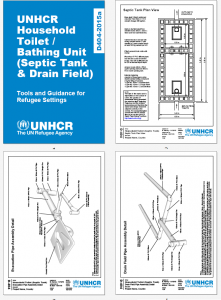
This document is a comprehensive and user-friendly capacity development tool for sanitation solutions in emergency settings. It provides detailed information on key decision criteria for tried and tested emergency sanitation technologies and information on cross-cutting issues such as inclusive design, soil analysis and institutional framework, relevant to come up with informed sanitation technology decisions in emergencies.
www.emersan-compendium.org

These Best Practice Guidelines were developed by Sanivation, a private sanitation company based in Kenya under UNHCR’s “Waste to Value” Project, funded by the Bill and Melinda Gates Foundation. The Guidelines are based on ongoing operational research in Kakuma Refugee Camp in partnership with UNHCR and the Norwegian Refugee Council (NRC), and will be update at the end of the Project in 2019.
Organisations: Sanivation.

These Best Practice Guidelines were developed by Oxfam under UNHCR’s “Waste to Value” Project, funded by the Bill and Melinda Gates Foundation. The Guidelines are based on operational research conducted in 2016 and 2017 in Jewi Refugee Camp in Ethiopia, where the Tiger Worm Toilets remain in operation and under regular monitoring.

Double vault Urine Diversion Dry Toilets (UDDT) can be used as an alternative to pit latrines in refugee camps. They utilise two chambers for faeces, one of which is in use whilst the other is full and drying so that it can be safely disposed of after an appropriate period of time.
These Standard Operating Procedures (SOPs) were developed by Oxfam under UNHCR’s “Waste to Value” Project, which was funded by the Bill and Melinda Gates Foundation. They are largely based on UDDTs developed under the Waste to Value Project in Ethiopia.

This document contains materials to help UNHCR and WASH actors build post pour flush household toilet and bathing units using the plastic SaTo Pan pour flush pan.

This document contains materials to help UNHCR and WASH actors build post emergency household pour flush toilet and bathing units with septic tanks and drain fields in refugee settings.

The book Emergency Sanitation: Assessment and programme design has been produced to assist those involved in planning and implementing emergency sanitation programmes. The main focus of the book is a systematic and structured approach to assessment and programme design. It provides a balance between the hardware (technical) and software (socio-cultural, institutional) aspects of sanitation programmes, and links short-term emergency response to long-term sustainability. The book is relevant to a wide range of emergency situations, including both natural and conflict-induced disasters, and open and closed settings. It is suitable for field technicians, engineers and hygiene promoters, as well as staff at agency headquarters.

The purpose of the manual is to provide practical guidance on how to select, design, construct and maintain appropriate excreta disposal systems in emergency situations. Relevant situations include natural disasters, relief for refugees and Internally Displaced Persons (IDPs), and complex emergencies, focusing on rural and peri-urban areas. The manual presents a process, which can be followed to assess the current excreta disposal needs and priorities, and to design an appropriate programme to respond to those needs. It can also be used to select appropriate excreta disposal technologies, systems, and hygiene promotion interventions. The manual provides guidance on how to plan, design and construct systems, and how to maintain and promote appropriate use of those systems.
Tags: Communal Toilets, Communal Toilets, Communal Toilets, Desludging and Excreta Transportation, Desludging and Excreta Transportation, Desludging and Excreta Transportation, Excreta Treatment, Excreta Treatment, Excreta Treatment, Excreta Treatment, Handwashing with Soap, and Hygiene Promotion. Organisations: WEDC and WEDC.

This document contains documentation to help UNHCR and WASH actors build urine diverting dry toilets (UDDT) in refugee settings. The package includes: Technical Drawings; Step by Step Construction Drawings; Bills of Quantity; Material and Workmanship Specifications; and Design Calculations.
Tags: Excreta / Urine ReUse, Excreta / Urine ReUse, Excreta / Urine ReUse, Excreta / Urine ReUse, Excreta / Urine ReUse, Excreta / Urine ReUse, Excreta Composting, Excreta Composting, Excreta Composting, Excreta Composting, and Excreta Composting.

This document contains documentation to help UNHCR and WASH actors mass-produce circular domed squatting slabs in refugee settings. The package includes: Technical Drawings; Step by Step Construction Drawings; Bills of Quantity; Material and Workmanship Specifications; and Design Calculations.
Tags: Excreta Management, Excreta Management, Excreta Management, Excreta Management, Excreta Management, Excreta Management, Excreta Management, Excreta Management, Excreta Management, and Excreta Management. Languages: English, English, English, English, English, English, English, English, English, and English. Organisations: UNHCR, UNHCR, UNHCR, UNHCR, UNHCR, UNHCR, and UNHCR. DatabaseDocTypes: WASH Design Documentation and WASH Design Documentation. Categories: WASH Reference Documents, WASH Reference Documents, WASH Reference Documents, WASH Reference Documents, WASH Reference Documents, WASH Reference Documents, WASH Reference Documents, WASH Reference Documents, WASH Reference Documents, WASH Reference Documents, WASH Technical Designs, WASH Technical Designs, WASH Technical Designs, WASH Technical Designs, and WASH Technical Designs.










